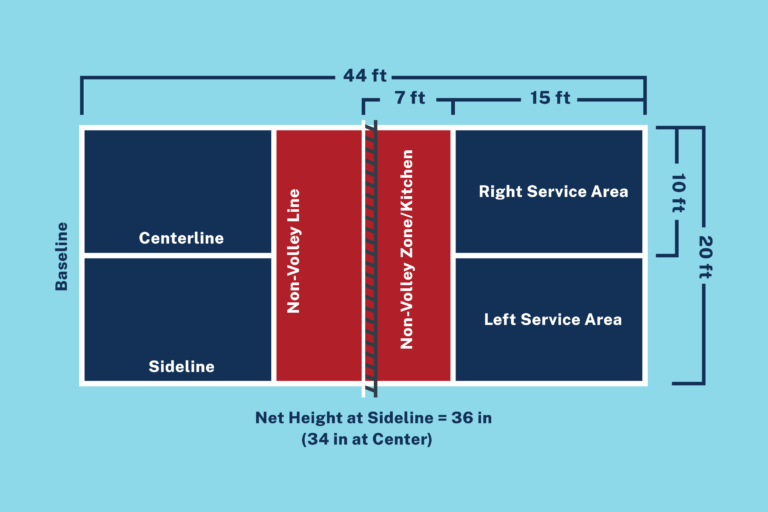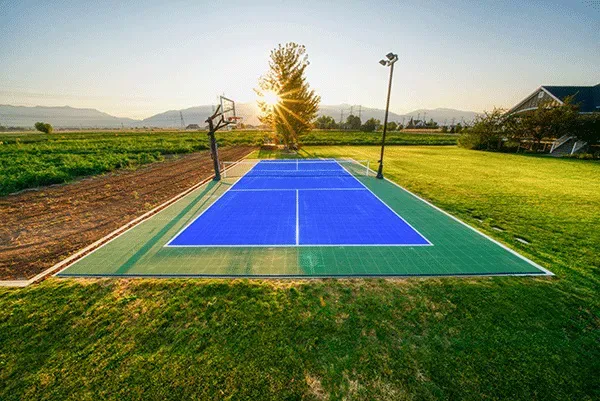1. Understanding pickleball court dimensions & regulations
To line a pickleball court accurately, it is essential to first comprehend the official dimensions and regulations set forth by the USA Pickleball Association (USAPA). A standard pickleball court measures 44 feet in length and 20 feet in width. Each court line should be 2 inches wide, which delineates various areas of play.

Breakdown of Court Areas
- Baseline: The line at the end of the court extends from sideline to sideline.
- Sideline: These are the vertical lines marking the width of the court.
- Centerline: This line splits the court into two equal halves, running from the baseline to the net.
- Non-volley Zone (Kitchen): A crucial area that extends 7 feet from the net on both sides, defining where players cannot volley the ball.
It's important to measure from the outside of the lines, ensuring accuracy down to the last inch. An insightful reference to visualize these dimensions would be a diagram, showcasing each area and its respective measurements, thus guiding you in the marking process.
2. Choosing the right location & surface
Selecting an appropriate location and court surface is vital for optimal gameplay. Here are some key considerations when determining where to set up your pickleball court:
- Surface Type: The most common surfaces include asphalt, concrete, or utilizing existing tennis and badminton courts. Understanding these surfaces helps determine the durability and overall playing experience.
- Minimum Playing Dimensions: Ensure any chosen area has at least 30 feet by 60 feet of open space to accommodate player movement comfortably.
- Utilizing Existing Courts: If considering existing tennis or badminton courts, it's notable that their dimensions align closely with pickleball courts, allowing for efficient conversion. This can help maximize space in community settings.

Pro-Tip for Indoor vs. Outdoor Courts
Take into account hazards such as overhead obstructions, ground texture, and weather exposure, especially for outdoor courts. Indoor courts can offer a controlled environment, free of weather-related interruptions, potentially increasing court usage.
3. Selecting line marking materials: Temporary vs. Permanent
When marking lines for your pickleball court, you'll need to decide between temporary and permanent line marking materials. Each option has benefits and drawbacks worth considering based on your specific needs.
Temporary Line Marking Materials
Common temporary materials include:
- Sidewalk chalk: Easy to apply and remove, visible but may wash away easily.
- Masking tape/Painter’s tape: Offers straight lines, but can peel off under weather conditions.
- Electrical tape: Sticks well but may be less visible depending on the color.
Pros and Cons:
- Visibility: Highly beneficial for test courts, as it allows easy modifications.
- Durability: Generally not suitable for long-term use as they can fade or be removed unintentionally.
Permanent Line Marking Materials
For a more lasting solution, consider:
- Court Paint: Delivered in various colors designed for outdoor exposure and sports performance.
- Textured paints: Help prevent slipping and enhance safety.
- Anti-bleed primers: Keep colors crisp and well-defined despite wear and tear.
Investing in the right type of paint will depend on variables like surface type and environmental conditions during application. Eco-friendly options are also available to minimize any environmental impact.
4. Essential tools and equipment
Before delving into the actual lining, ensure you have all necessary tools. Here’s a list of essential equipment you’ll need:
- Measuring Tapes: Use both 25 and 50-foot tapes for accuracy.
- Framing Square: Ensures right angles are maintained throughout.
- Chalk line and reel: Helps create long, straight lines with precision.
- Rubber Mallet: Ideal for securing any stakes you may use.
Consider utilizing a line taping machine if you're aiming for efficiency, particularly if working with larger areas. This will speed up the process and ensure that your lines are straight and uniformly spaced out.
5. Step-by-step guide to temporary line marking
For those who want to experiment with a temporary setup first, follow these steps:
- Setting Up the Net: Start by establishing a net in the center of the court, as it will be your main reference point.
- Using the 3-4-5 Rule: This method helps create a right angle. Measure out 3 feet from the net, 4 feet along the side, and adjust until the diagonal equals 5 feet for perfect right angles.
- Marking the Lines: Using your chalk or tape, outline the baselines first, followed by the sidelines.
- Non-volley Zones & Centerline: Measure 7 feet from the net for the non-volley zones, and finally outline the centerline.
Visual aids, such as diagrams outlining each dimension, will be beneficial to those unfamiliar with court layouts.
6. Step-by-step guide to permanent line marking
Transitioning to permanent lines may seem daunting, but with thorough preparation, it can be straightforward. Here’s a break down of essential steps:
- Surface Preparation: Begin by cleaning the surface of the court. Remove any debris and ensure it’s free of cracks.
- Using Tape for Guidance: Before painting or applying permanent lines, you can use tape to outline your marked areas to guide your paint application.
- Paint Application: Use a quality brush or roller to apply the paint, ensuring it fits evenly within the parameters of your marked lines.
- Sealing the Lines: After the paint has dried, sealing can help maintain the line's integrity against weather and wear.
Next, consider the importance of applying paint during favorable weather for effective curing.
7. Adapting multi-use courts: Tennis & basketball courts
In many communities, the need for adaptable game spaces leads to the coexistence of multiple sports. Here’s how to harmonize pickleball lines with existing tennis or basketball courts:
- Using Existing Lines: If using a tennis court, leverage the existing lines for the baselines and sidelines, adjusting for the 2-inch width of the pickleball lines.
- Color Considerations: Choose a contrasting color to distinguish pickleball lines. For example, if tennis lines are white, opt for yellow for pickelball.

Leaving Gaps at Line Intersections
Allowing gaps where lines intersect can enhance clarity for players, helping avoid confusion during matches.
8. Maintaining your pickleball court lines
Once your court is marked, regular maintenance ensures longevity:
- Check for Straightness: Periodically assess the lines for any warping or misalignment.
- Re-taping or Repainting: Replace any areas that show wear or fading to maximize playability.
- Regular Cleaning Methods: Use a gentle cleaning solution and soft bristle brushes to keep lines visible.
Consider establishing a maintenance schedule, checking every few months based on existing weather conditions.
9. Common mistakes to avoid
While marking your pickleball court, sidestep these common pitfalls:
- Duct Tape Usage: It’s tempting to use duct tape due to its convenience, but it often leaves residue and can damage surfaces.
- Neglecting Surface Preparation: Skipping this step results in poor adherence of paints or tapes, leading to early wear.
- Incorrect Materials: Ensure you're using materials suitable for court marking. Incorrect choices can result in hazy lines or quick deterioration.
10. Community-focused approach: "Pickleball court mapping"
Addressing the social aspect of pickleball can greatly enhance community engagement:
- Community Involvement: Involve local players in the lining process, garnering ownership and commitment to maintaining the court.
- Accessibility for All: Choose locations that can be easily accessed by individuals of varying skill levels, including those with disabilities.
Sustainability is also a key element. Opt for eco-friendly marking materials that minimize environmental disruption while maximizing usable space.
Conclusion
Successfully lining a pickleball court involves understanding the standard dimensions, selecting appropriate materials, and executing a careful marking process. Maintaining a well-marked court guarantees players enjoy fair gameplay, enhancing their experience and fostering community engagement. With this guide, you can approach the project with confidence, ensuring a beautifully lined court ready for action. So roll up your sleeves, gather your materials, and get ready to indulge in the sport with a professionally marked pickleball court right in your community!










